
Born March 3, 1957, in Toronto, Eric spent his childhood and
adolescence in that city's west end "where the majority of
the people I grew up with ended up in jail or in troubled spots. I think
the reality is that life is not necessarily a bowl of cherries for people.
I believe two themes run through my stories. One is a sense of belonging -
people want to belong somewhere. The second theme is that, whether you're
female or male, you have some power to make changes in your life. Life
does not have to just 'do to you.' You can make a decision that you're
going to do things for yourself and overcome. There's nothing more
wonderful than overcoming adversity, to stare it in the eyes and to win.
We don't have to be victims. One of the societal trends I see is looking
for someone to blame for what's gone wrong for you. You've got to take
responsibility for things. Rather than finding an excuse to fail, find a
reason to succeed."
Books by Eric Walters This article is based on an interview conducted in Mississauga, ON, on
Sept. 26, 1998. Visit Eric Walters' home page at
http://www.interlog.com/~ewalters
Eric Walters
Profile by Dave Jenkinson.
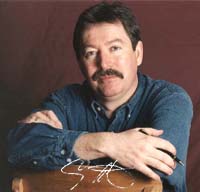
"Going through school, I wanted to be a psychologist. I got an honours
degree in psychology in 1979 from York University and started working as a
social worker. I took both my Bachelor's and Master's of Social Work via
part-time studies. When I was about 10 to 15-years-old, I thought teaching
would be a good thing, but, when I was going through school, I realized
that there was absolutely no way I was going to become a teacher with the
market the way it was. Then, when things opened up, I thought, 'I'm going
to go back and do this' because it still appealed to me. I got my Bachelor
of Education from the University of Toronto while I worked full-time as a
social worker in the evenings."
While Eric has been teaching kindergarten to grade six full-time for some
10 years, he still maintains his social work connection. "I work evenings
and weekends half-time in the emergency department of Credit Valley
Hospital where I do such things as death and grief counselling,
psychiatric evaluations, suicide assessments, work with victims of child
abuse, domestic assault, any form of violence, breakdowns, anything."
Asked to explain how he manages both jobs plus writing, Eric replies,
"There's that old saying about 'change being as good as a rest.' It's
true. Teaching and social work are such different jobs, and each gives
such perspective on the other one. I really like both of them
tremendously."
"In my life, what I've often found are people continually saying, 'You're
going to burn yourself out.' I've been working full-time basically since
grade 11. I've always had a full-time job on top of going to school. I did
my BSW part-time while working full-time, and I got two years of credits
in two years and two months. The Social Work faculty kept saying, 'You
can't do this. We won't let you,' and I'd respond, 'Well, that's fine, but
shouldn't I be the one to determine what the limits are of my energy?'
It's like someone saying, 'I'm cold. You should wear a sweater.' Some
people have a lot more energy than me, and some people have less, but
shouldn't it be my decision how much energy I want to devote? I like doing
things and to keep moving. If someone says you can't do something, it
almost gives you incentive to go harder. An editor sent me a rejection
that basically said, 'We don't want your book, we don't think you should
write, and we don't think you should live,' and then added at the end,
'Perhaps I'm being a trifle bit bitchy.' I kept that letter because people
like that are a wonderful motivation to go on in life."

"My first book, Stand Your Ground, was written, as are almost all
my books, for the class I was teaching at the time. I do two or three
books a year in class. I change with the units. We were doing a local
studies unit, and I needed a local book. Because I didn't happen to have a
Streetsville book, I wrote one set in the school, Vista Heights, and a
number of the book's characters are kids I was teaching. Occasionally, you
have these wonderful little things that intersect. I was doing a school
presentation, and a teacher said, 'You probably don't remember me, but
maybe you recall my son, Scott. He was in your class when you wrote
Stand Your Ground. He hated reading until you started that book,
and now he's in his OAC year."
"Stand Your Ground was actually written backwards. I wrote the
last chapter and wrote backwards for the class which certainly confused
them I think. One of the kids, a big kid named Mike who's actually the
character in Stranded, said, 'You know, Mr. Walters. I was looking
at all the garbage in the library, and your book isn't half as much
garbage as theirs." A typical Mike compliment! He added, 'Send it off,'
and so I did. I got The Canadian Writers' Marketplace and just mass
submitted. I think I had five rejections before getting lucky with an
editor, Elsha Leventis, who liked it."
"I've been so fortunate with editors. I've never met one who didn't make
such a positive impact on a book through the changes they suggest.
Sometimes I almost feel guilty because it's my name on the spine, but at
least 25 percent of what evolves in the book is from the editor. When
talking to classes, I describe the process - the 350 changes the editor
wants and the back and forth. I'm never happy when editors suggest
changes. My initial response is annoyance because it's written and I'm
through with it. That book really doesn't interest me nearly as much as
the one I'm writing now, and I've got to leave it to come back to make
these changes. But the changes are always good, and the products are
always right. Intellectually I know that, but emotionally I'm going back
over a path I've already gone, and so I never like that initially."
"I've been told some writers love that revision process. Not me. I love
the first draft. Sitting down and just writing it is having fun. Usually I
have an idea where the book's going to go, but the characters continually
shock me. They'll say things or start off in a direction, and I'll have no
idea that they're going to do that. For me, it's almost like, 'Why are you
saying that?' If you have an idea of where you want it to go, you
sometimes try and grab the characters and pull them back in that
direction, but it usually isn't right. Usually they know where they're
supposed to go. That sounds psychotic, but I swear that, if I opened my
laptop up slowly enough and peeked underneath, the characters would
already be talking."
Most of Eric's central characters are 14. "It just seems to be that cusp
age between childhood and adult. I'm going a little bit lower age-wise
with some recent novels. In Tiger by the Tail, my main character is
13 while in Three-on-Three, a
basketball book, the main character is 10. I'm trying to go down a little
bit farther just to amuse myself, but I think 14 is such an incredible
age. My oldest daughter, Christina, has recently turned 14. That's her on
the cover of Trapped in
Ice, and when you read about Christina in Stranded that's
also her. I wanted her personality. I hate helpless female characters with
a passion."
"Because I have very little perspective of being a 14-year-old female, I
started writing as male characters. When I began my fourth book, the kids
in my class who'd read the first three said, 'Why are you always writing
males as leads? Are males more important, more adventurous?' The answer, I
realized, was that I was buying into what I'd read and I hadn't thought it
through. Consequently, the next three characters I wrote were female
leads. I want my females to be strong. In Trapped in Ice Helen has
evolved from a very bookish, letting-the-world-act-upon- her type person,
to someone saying, 'I can take command of this.' I like females to take
command of the situation, and that's why I try to get those strong
characters like Summer in Diamonds and Christina in
Stranded. I want them to take control of their lives, and I want
little girls to realize that they're powerful and not ever to take a
backseat to anybody."
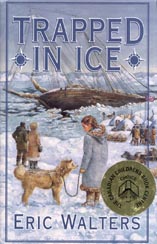
Trapped in Ice was
another book which came out of Eric's classroom work. "One of the things I
do when I go to schools is ask, 'Who can tell me the name of the first
Canadian Prime Minister?' and usually it's one person per class. Because I
found that Canadian heroes were being ignored, we did a whole Canadian
focus at school where we painted a giant scale map of Canada and learned
the provinces. Our speeches were on Canadian heroes, and announcements
every day were about Canada. I took 10 Canadians and made them into short
fictionalized stories. Robert Bartlett was one, and I just loved this guy.
He was a hero, but, again, what I don't want is just someone who is heroic
and a jerk. I want someone with integrity, and Bartlett was a man of
extreme integrity - well read and well spoken. Bartlett's the sort of
person I'd like Canadians to look up to. We don't have heroes. Wayne
Gretzky's a fine fellow, but he's a hockey player, not a hero."
"While researching Trapped in
Ice, I found Robert Bartlett's nephew, a retired Supreme Court
judge. When I sent him the manuscript, one of the things he objected to
was that I'd given his uncle an accent. 'But Bartlett's from Newfoundland,
an outport community,' I said. 'You mean he doesn't have an accent?' 'No,'
the nephew replied. 'Well,' I said. 'I have one. It's a Toronto accent,
and I'm not giving Bartlett my Toronto accent. He's having a 'down east'
one."
Eric's research on Bartlett began in an odd way. "I found a historical
book on him in the discard bin of the library when I had my class there.
It cost me fifty cents, and so that was my primary research. When you've
got somebody as wonderful as Bartlett, you just have to take the pieces
that have been given you and craft around them. That whole episode
involving the ship's sinking and his playing the funeral march on the
phonograph, who could ever think of that? That's beyond creativity. It was
wonderful. I wanted to write the novel almost just for that scene. Then I
did peripheral research. I found out about polar bears from a doctor who
spends her summers in the Arctic, and I went outside without my coat on
and experienced bad storms and just felt what it was like."
"I like doing things experientially. Actually, research is incredible fun.
For Diamonds in the Rough, I went into a rather nasty biker bar in
downtown Toronto, sat there with my pen and paper and ordered a coke. Five
bikers came over to my table and demanded to know I was doing. As one of
them threw my pad on the floor, I start explaining. He picked up my paper,
brushed it off and said, 'We can tell you some stories.' I love when
people tell me stories."
Stories also became part of the research for War of the Eagles.
"Besides getting information from my father, I phoned the Chamber of
Commerce in Prince Rupert and said, 'Can you give me the names and phone
numbers of some people who were in Prince Rupert in 1941?' Using that
information, I called people and said, 'My name's Eric Walters. You don't
me, but I write children's novels. Could you tell me a story about being
in Prince Rupert in 1941?' When I tell kids this during presentations,
they say, 'They hung up on you, didn't they?' No, they told me stories,
wonderfully touching, loving, disturbing stories. And that's why I do a
lot of the research - I love interviewing people."
While the stories people told didn't find their way directly into War of the Eagles, Eric
says that a number contributed to emotions found in the book. "The
closeness between the two characters, Jed and Tadashi, is one example. A
woman told me about her best friend, a Canadian of Japanese descent, who
was being shipped out. The woman, only learning about her friend's leaving
on that day, ran to the train station where they talked and talked. Just
as the train was leaving, the woman pulled off the necklace and locket her
grandmother had given her and passed it up to her friend. The train went
away, and she never saw her friend again. As she told me the story of what
had happened 50 years before, she began crying, and I started crying too.
And so that emotional integrity was there in the book in terms of the
boys' friendship."
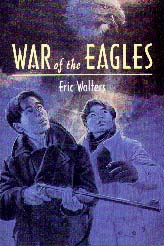
"In another instance, I was talking to someone who said, 'You know what?
Them Japs got what they deserved.' It was like getting hit in the side of
the head with a shovel. I didn't even know what to say. I should have
asked, 'Was your brother killed? Was your father in Hong Kong?' But I just
couldn't. At that point, I was just so shocked by the anger that's still
part of their memories. And so I used the anger at the use of that word in
the scene where Jed confronts the looters."
"Parts of War of the
Eagles are directly from my father's story. There's a family
picture of my father holding a dead eagle in 1943 in Prince Rupert. When I
was 11, I saw this picture and asked him to tell me the story. Thirty
years later, it inspired the novel. The soldiers were always killing
eagles, and they actually threw a live eagle, the base mascot, into the
showers. In school visits, I talk to kids about using family histories and
show them a blow-up of the picture. My job is to teach something about
creative writing and story development, how you develop a character or
where stories come from - newspaper articles, family histories. I love
going in and doing some teaching, and the feedback I get is that the kids
want to read my books. More importantly, they want to write, and that
means much more."
"When I'm doing these presentations, I also talk about character
development and we develop a character. Then I'll ask, 'Do you want me to
juggle?' I take a bean bag and throw it up in the air. No one's too
impressed. I take a second so that I'm juggling two, and they're a little
more impressed. Then I do three and say, 'Now I'm really going to show you
something.' I grab a bunch of things and walk over and stand so that I'm
over top part of the audience. 'Now, I'm going to juggle,' I say, and
those underneath me panic. I point out that I know some people who maybe
can do this, but I can't. Three's my limit, and, in a book, that's about
all I can ever juggle - a main character and two secondary. There's room
for three, and, beyond that, they're more peripheral."
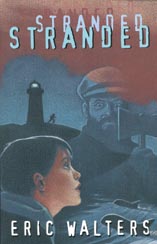
Stranded is quite different from Eric's other books, and he
acknowledges that the difference was very deliberate. "I don't like
writing the same thing twice. Even if my characters have similarities, I
like to try a new departure. I wanted to try the time line which I never
had done. I also wanted a spooky story, and so I threw in the ghost story.
Actually, another book I have coming out in the fall of 1999 is called
Visions, and, for it, I took really eerie, spooky, scary Inuit
fables and wrapped them around the story. I know you're not supposed to
say bad things about other authors, but 'Goosebumps' drive me crazy. Kids
get into the continual loop of them. I want genuine scary. Actually,
William Bell's Five Days of the Ghost is my 'Goosebumps' antidote.
I'd read a 'Goosebumps' to the class, and we'd quickly analyze it. Then
I'd read Five Days, and we'd critically analyze that. And the kids
would say, 'Five Days is scary; that's garbage.'"
How Eric begins a book seems to vary with each book. "Sometimes, as with
War of the Eagles, I
have an idea and write from that idea. I had a little bit of a story, and
I went from there. With Trapped in Ice, I had the
bare bones of an entire story just waiting to be fleshed out. In the case
of Stranded, I asked the kids in my class to bring in newspaper
clippings about whales because we were going to do a whale unit and I
didn't have a story to write for them. Someone brought in a clipping about
stranded pilot whales, and the book just evolved from there. For instance,
I sent two kids out to the parking lot and said, 'Count the number of
cars.' They came back with the answer, 'Twenty-four.' I said, 'Well,
there's 24 stranded whales.' Then I said, 'Go out and see if all the cars
are the same size.' 'Why?' they asked. 'Big cars will be males; little
cars will be babies; and medium size cars will be females.' So
Stranded evolved from there. With some stories, I just have a
character who interests me, and I let the characters talk, and they sort
of sort out what the plot is going to be. I didn't have much idea at all
when I began STARS. I just
thought, 'Car theft ring, get caught, get sent up north,' and then the
characters evolved. I try not to take rejection too personally, but
Joseph, the central character, is so near to my heart I would have taken
that one very personally if it had been rejected by publishers. STARS was actually the first time
I ever tried to write a novel away from school. I sat down during my
daughter's nap time one summer and wrote for an hour and a half a day for
31 days to get STARS."

"I try and write every day. I can write almost anywhere. I was joking with
one writer because she talked about where she writes, the perfect setting,
and I write at the food court at Bramelea City Centre if that's where I am
for lunch. If it's a long traffic light, I'll open my computer. Basically
I'm always evolving stories and ideas, and I don't need much time. At the
hospital, I'll see a patient, and, while I wait for the doctor I need to
confer with, I'll open the computer and write a paragraph and a half,
close it back up, and talk to the doctor. I always write on the computer.
I cannot write paper and pencil anymore. I can't edit on computers to save
my life though. I have to write on the computer and edit on hard copy.
When it's on a computer screen, it looks perfect."
Unlike many authors, Eric has a variety of publishers. He explains,
"Publishers publish very slowly, and I've written seventeen novels and one
picturebook since 1993. Publishers have a pace they want to work at, and I
have a pace I want to work at. I don't like waiting for anything so I go
after publishers. At one point, I had an agent, but that didn't work so I
became my own agent, and then I had success. For example, I met Marie
Campbell of HarperCollins at the Silver Birch lunch, and two weeks later I
called her and asked, 'Would you like to see a novel?' At this point, I
think the agreement is that Penguin will have first crack at historical
fiction, unless it's related to Eagles because there'll
be a sequel, Caged Eagles, in the fall of 2000. HarperCollins has
been very good with the contemporary stuff. Orca has been wonderful as
well. These are nice people, and they've been saying, 'You've really got
to be selective." And I don't want to compete with myself."
An example of how Eric does not compete with himself can be seen in two of
his 1999 books which, although their age audiences overlap, are from
different genres. "Tiger by the Tail has a female character. It's
about a couple of kids who wander into an old deserted farm. They go into
the stable area to get away from a storm and are confronted by a tiger in
the stable's basement. It turns out that an old man who retired from the
carnival has brought with him his exotic animals - a cheetah that's too
old to move, a monkey that drinks Coke from the fridge, a parrot that only
says nasty things to people, and the tiger that got loose when local
teenagers let it go. The kids have to help the old man bring the tiger
back."
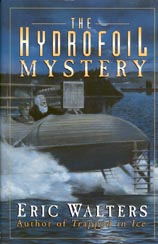
"The Hydrofoil Mystery is historical fiction featuring Alexander
Graham Bell. It's set in Baddeck, Nova Scotia, in 1917. Researching
Alexander Graham Bell was one of the most enjoyable things I've done in
terms of writing or reading in years. I'm delighted that people are going
to have a chance to see this guy because he was a genius, a word that gets
so misused. There was da Vinci, then there was Bell, and there's nobody
else who's on that level. But beyond being a genius, Bell was a devoted
husband, wonderful father, and incredible grandfather. Kids have to know
about these sorts of role models. It was the most playful novel I've ever
written because it's a mystery. I really had fun with it. I've got to give
Eric Wilson credit for his suggestions and information. I really like
mysteries, but I'd never written one."
The Hydrofoil Mystery was inspired by my daughter Christina. While
holidaying in Baddeck, Nova Scotia, we were sitting in the hydrofoil
gallery, and Christina did what she always does - she said, 'So what story
would you write about here?' I replied, 'Well, maybe I'd ....' and, before
we left, I had the story outline. Then I ran and found paper and started
writing the outline down. Bell was a great guy, right down to his sense of
humour. He loved playing practical jokes. He had a big stuffed bear that
he used to leave in places for people to stumble into. Sometimes he'd put
it on the road in front of his estate, and he'd hide in the bushes and
watch people's reactions as they came by. I included a scene like that,
but I didn't have to think it up. This was Bell."
Fall of 1999 will see the publication of Three-on-Three, "a basketball
story set in Clark Boulevard Public School. I was running a three-on-three
basketball contest and was writing on demand. I had to keep one chapter
ahead of the kids. Appearing the fall after that will be The Magic of
Oak Island which is set off the east coast. I did my research for the
Oak Island book via the internet. I have a central character who's a
magician, and he takes the typical magician approach that, if everyone has
been focusing on the pit, then it's not there because that's not how magic
works. If you're focusing there, it's because things are really here, and
so he does this triangulation and figures where the 'treasure' really is.
I'm now reading that that's what they think the situation is - the money
pit is the fake part. There's something somewhere else, and they've
started digging at the other end of the island."
Asked if he was familiar with Joan Clark's The Hand of Robin
Squires, which posits one explanation for the "treasure pit," Eric
replies, "If somebody's written something about what I'm writing, I try to
avoid it if I can." But Eric does admit reading Budge Wilson's
Sharla "because I'm writing a novel with Churchill, Manitoba, and
polar bears. I read Sharla, and I'm OK because I took an entirely
different tack. The novel's about this kid, Kevin Spreekmeester, who
enters a capture-Mississauga photo contest and wins. The prize is a trip
to Churchill and the opportunity to work with a world famous National
Geographic photographer. Now, I have a friend by the name of Kevin
Spreekmeester who lives across the street, who entered a capture-
Mississauga photo contest, and who won a trip to Churchill, Manitoba, to
photograph bears with.... When Kevin told me his story, I thought, 'This
is a novel.' So now Kevin's 13 again and has his hair back. He's just
happy that Spreekmeester's going to be in print."
"I also have two novels coming out in the spring of 2000. One, from
Stoddart, is called Rebound. It's about a kid who's in a wheel
chair after being paralyzed in a car accident. The other, which Penguin's
doing, is The Bully Boys, about the War of 1812. I'm using James
Fitzgibbons as my main hero. I've got a 14-year-old who's there with
Fitzgibbons witnessing what's happening. I'm going to try something
completely different. My 14-year-old's going to kill somebody, and I'm
going to have it happen in a very bloody, painful, moaning way where he's
going to have to sit there and look at this person who's dying and that
he's killed. He'll have to look him in the eyes, and this guy will say to
him, 'Can you tell my wife? Can you tell my kids what happened to me, and
can you give this to them?'"
"I want to make the death vivid because I have this theory.
Developmentally, little boys and little girls are born at the same level,
and then little girls grow ahead faster, and boys catch up at about age
75. Boys really think that war is this fun game, and I want to make it
vivid. I'm not going to let this be a gratuitous war book, and so my
character is going to start off thinking that war's fun and have a 'Boy, I
wish I could be there' attitude. I want this to hit hard in the end.
Through my hospital work, I've been around gunshot wounds and knifings.
It's just awful what you see. You've got to make violence the way violence
really is, and not like cartoons and on TV."

Diamonds in the Rough Eric dedicated "to all those teachers who
spend their careers finding diamonds and making life less rough." Eric
explains that "I've had so many good teachers. When STARS won the Silver Birch, I
invited my grade five teacher to the luncheon because I wanted a chance to
thank her in front of 1200 people for what she did in terms of inspiring
me to write but also for just inspiring me period. Her name is Christina
Gay. She's 73, retired on Toronto's Centre Island, travels the world and
does volunteer work. She's incredibly special to me. She's still somebody
I'm in contact with, and she's still inspirational. As I said, my Mom died
when I was young, and I was raised by a single parent. There was a lot of
poverty in my family, and Christina Gay was somebody who made me realize
that there was something worthwhile in me. She was there at the right
time. It's one of the things you hope for as a teacher. I had a university
prof, Dorothy Herberg, who taught me incredible things, and during my
B.Ed. placement period, I was fortunate to be with a gentleman named Larry
Swartz. Even now, when I teach, I always think, 'What would Larry think of
this?' I've been fortunate enough to have these people at many different
stages of my life."
Eric took the 1998-99 school year off from teaching and is anticipating
doing the same for 1999- 2000. "The purpose is promotion. I'm aiming to
talk to over 75,000 kids this year. In just one week, I did 20 one-hour
presentations with 100 kids per presentation. I look at the wonderful
writers who have not had great success, and I think the difference between
success and lack of success is promotion more than it is skill. There's
too many good people who don't get noticed. In the past three months, I've
walked into more than 100 bookstores and said, 'Hello. My name's Eric
Walters. Would you like me to sign my books, and then I can help you move
them to the front?' Blatant self promotion seems to be the key. And you
feel a little bit embarrassed because it's not the way you've been raised
to do things, but I'm doing it."
"I can't see doing anything full-time. What makes things interesting is
the variation. If I won a million dollars, I don't know if I'd teach
anymore, and I'd cut down the hospital shifts dramatically, but I'd still
be writing because I only write what I enjoy."
